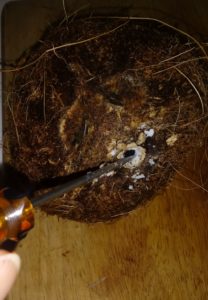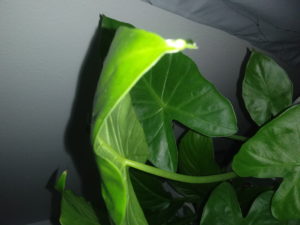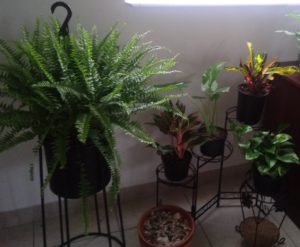 Removing the water from a dried coconut might seem tricky for some people, so I’m going to tell you a trick that I use to remove the water without spilling any of this delicious hydrating drink.
Removing the water from a dried coconut might seem tricky for some people, so I’m going to tell you a trick that I use to remove the water without spilling any of this delicious hydrating drink.
Before I learned about this little secret, I always lost a lot of my coconut water. I’m so glad I found out the easy way to remove the water, so much that I have to share this simple tip with all of you.
I love to wash my coconut off first, since so many people tend to pick up the coconut, shake it, or test if it’s good. After washing the coconut thoroughly, I use a piece of napkin to dry the shell off.
 Next, you’re going to get a slim screwdriver, one that is clean and free of rust. This will be used to bore a hole in the soft eye of the coconut. The coconut three eyes are located at the top of the shell. One of these eyes is soft enough to pierce with a sharp object so that you can get every drip of the coconut water out without wasting any.
Next, you’re going to get a slim screwdriver, one that is clean and free of rust. This will be used to bore a hole in the soft eye of the coconut. The coconut three eyes are located at the top of the shell. One of these eyes is soft enough to pierce with a sharp object so that you can get every drip of the coconut water out without wasting any.
After piercing a hole in the shell of the coconut, I place a strainer over a container and drain out the water. The strainer helps to catch any broken parts of the shell or other debris, so you can drink your natural, delicious, healthy coconut water undisturbed.
Lime With Coconut Water
 Give your coconut water an extra zest by squeezing some lemon or lime juice in it. This is so refreshing and nice, especially in hot climates, not to mention if it’s ice cold. This is the perfect natural drink to beat the heat.
Give your coconut water an extra zest by squeezing some lemon or lime juice in it. This is so refreshing and nice, especially in hot climates, not to mention if it’s ice cold. This is the perfect natural drink to beat the heat.
It also seems to give me some extra energy as well when I drink my coconut water with lime juice. Lime to me has a more sour and tangy taste than lemon, so I like that extra kick to my coconut water. Now that you’ve learned how to get water out of a coconut, go get your own coconut and enjoy this refreshing drink.

 If you have indoor plants, you may notice that some of them do well while others tend to not do so good. That is because some houseplants need high humidity, which is recommended to be between 50 to 60 %, with tropical indoor plants needing even up to 80% humidity.
If you have indoor plants, you may notice that some of them do well while others tend to not do so good. That is because some houseplants need high humidity, which is recommended to be between 50 to 60 %, with tropical indoor plants needing even up to 80% humidity.